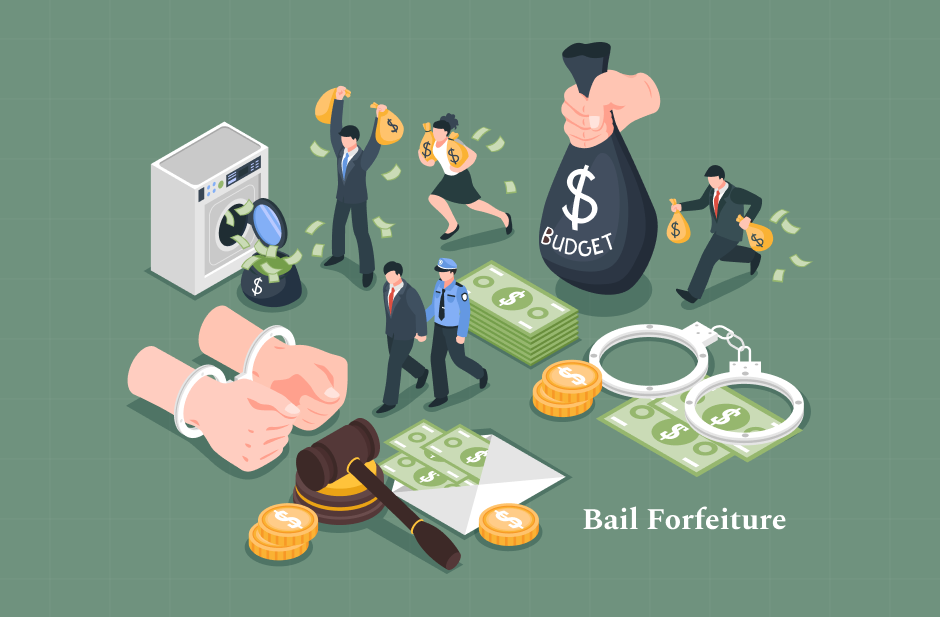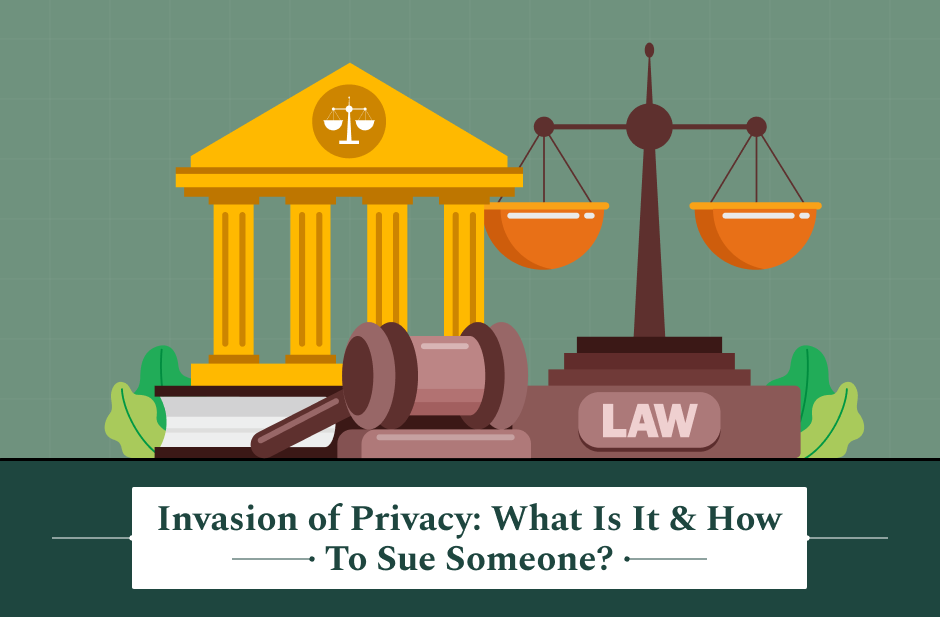Bail forfeiture is the act of formally seizing the defendant’s money, property, valuables or collateral in a case when they fail to appear in the court proceeding.
Thus, the bail forfeiture meaning is simple. The defendant in a proceeding promised to appear in court. However, they broke the promise. Consequently, the court can now seize the funds that the defendant kept as collateral.
Forfeiture of Bail ensures judicial efficiency. According to the California Penal Code § 1305 (California State Legislature), “A court will declare a bail bond forfeited if a defendant fails to appear for a required court date without sufficient excuse, such as arraignment, trial, or sentencing.”
According to Stephen G. Rodriguez & Partners, for a bail forfeiture to happen, these are the conditions that need to be met.
A defendant should:
- Fail to appear
- For their arraignment, a trial, or judgment.
Additionally,
- If the said defendant does not appear in any stage of the trial when the court legally demands them to.
- If the defendant does not surrender during the execution of the court’s judgment after appeal.
- All without a proper excuse.
Judgment Of Bail Forfeiture
Provided these conditions hold true, the honorable judge declares the bail “forfeited” in “open court”.
What Happens After?
Usually, there are two scenarios arising out of the situation ( forfeiture of bail or bail loss). They are:
- The company issuing bail bond has to surrender the defendant to the honorable court. This should happen within 180 days of the forfeiture of Bail. In this case, there are no financial consequences.
- Or, the company can also choose to pay the original posted amount of the bail bond to the honorable court, in full.
Court Order
However, if the company does neither, a court order will follow. This order legitimises the court to retain the bail. This step is the formal execution of the forfeiture. The financial guarantee gets transferred to the US Treasury (bail money or value of the pledged collateral).
Why Is It Important To Comply?
Yes, sticking to the bail conditions is quite a non-negotiable deal for a defendant looking to stop bail forfeiture. Non-compliance often makes the defendant a flight risk.
Moreover, non-compliance of bail orders is a huge disrespect to the law and courts. This can lead to penalties, financial loss, and more. Thus, the concept of forfeiture provides a financial incentive for one to uphold the pretrial release contract.
Legal Framework
Bail forfeiture follows state criminal procedure codes, says Notre Dame Law Review. The procedure codes are laws that come with stringent timelines. Thus, all courts follow these when issuing arrest warrants in forfeiture cases i.e. failure to appear (FTA) [NCSL].
Many feel that the complexity and the stakes involved in these cases demand precision from all parties involved.
“Failure to appear is one of the main culprits behind an enormous backlog of warrants in the U.S. Bench warrants, issued by courts for procedural issues like missed court dates, order the police to find and arrest a person and bring them before the court,” states the Article by Prison Policy Initiative.
What Is Bail? Definition And Purpose
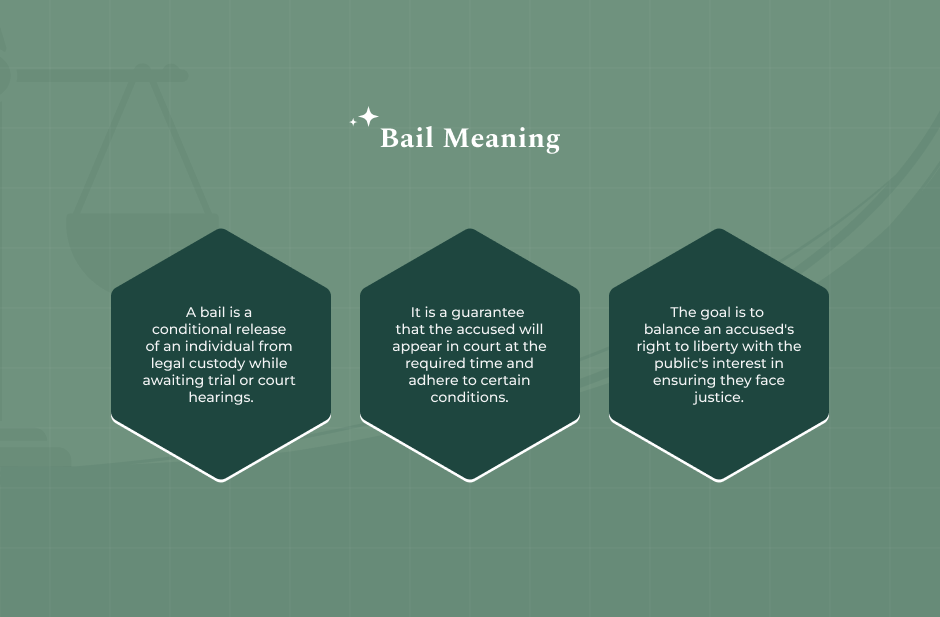
According to Liggett & Goodman, P.C., “Bail is a financial guarantee.” Bail allows a defendant to be released from police custody. This is done with the condition that the defendant will return for all dates scheduled by the court.
Release of the defendant is a manner in which the justice system lets the accused prepare their defense case while also balancing public safety.
What Are The Types Of Bail?
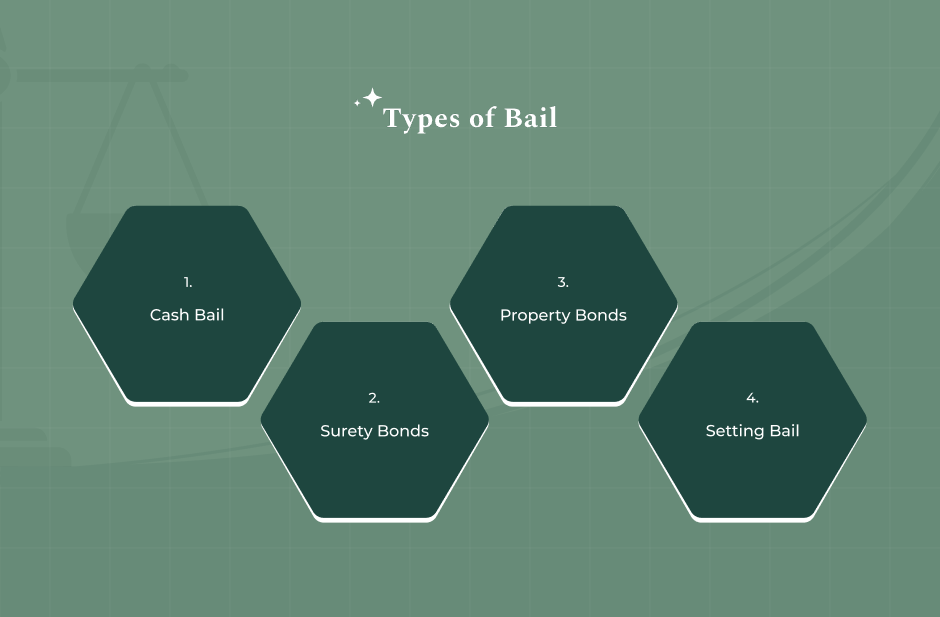
Now, let’s find out the different types of bail that can be subject to a bail forfeiture under the US legal system.
Cash Bail
In this kind of bail, the defendant or any third party can submit the full bail amount. The court returns the complete amount to the payer if the defendant makes all court appearances.
Consequently, when bail forfeiture occurs, the payer loses the complete bail amount.
Surety Bonds a.k.a Bail Bonds
Bonds are the most prevalent form of bail in the US. In such cases, a defendant makes a payment of a premium which is typically 10% to a licensed bail bondsman. Moreover, this payment is non-refundable.
After that, the bondsman will guarantee the complete amount of the bail to the court. If the defendant does not turn up in one of its appearances, there is a bail bond forfeiture.
Property Bonds
In this kind of bail, the defendant keeps their real estate and uses it as collateral. Thus, during forfeiture, the court seizes and liquidates said property to cover full bail amount.
Setting Bail
According to May Law, LLP, Judges consider several factors when they set the bail amount. These factors include the following:
- Severity of the crime.
- Criminal history of the defendant in question.
- Defendant’s ties to the community.
- Financial ability of the defendant.
- Chances of the defendant fleeing.
Read Also: Can You Bond Out On A Capias Warrant?
What Does US Law Say About Protection Of The Defendant In Bail Forfeiture?
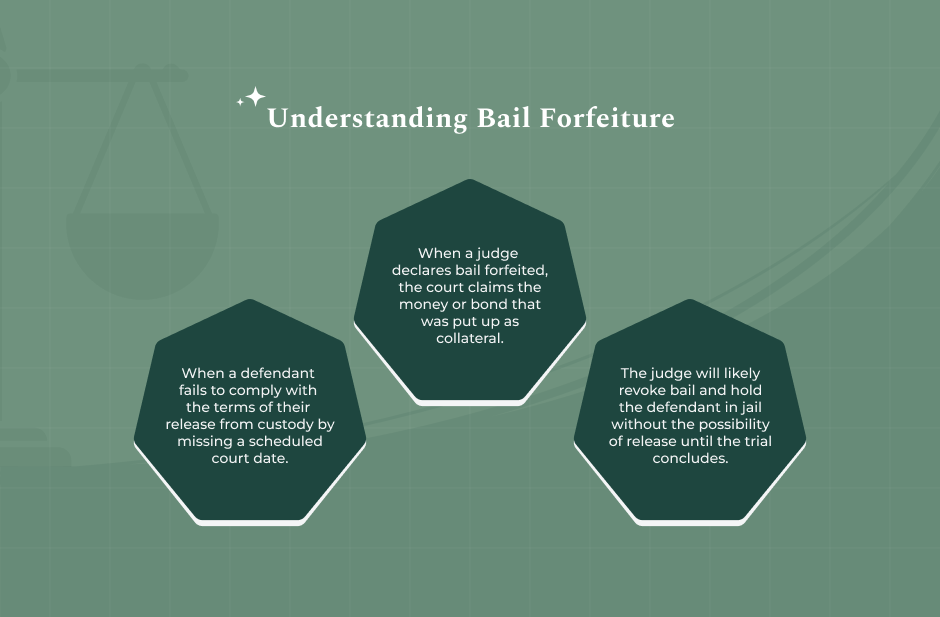
The Eighth Amendment prevents excessive bail, but the amount must be sufficient to compel the defendant’s return.
Cashless bail is what we also call bail reform. It is a criminal justice policy that says that the defendant’s release before trial does not depend on their ability to pay their bail.
This system started because many held that the cash bail was discriminatory. They gave instances where people of color or of limited means enjoyed limited freedom when it came to bail.
However, 2025 saw some considerable reform in this regard. A recent article in Findlaw says:
“According to a new executive order, the president wants to divert federal policies and resources, “to the maximum extent permitted by law,” away from supporting jurisdictions that have tried to dial down or eliminate cashless bail.”
Additionally, in an article, The Washington Post talks about how President Trump signed the order to end cashless bail.
Causes Of Bail Forfeiture
A bail forfeiture occurs primarily when the defendant breaches the terms of their pretrial release contract.
Failure To Appear
Bail forfeiture and failure to appear (FTA) go hand in hand. Thus, once the defendant does not appear at their scheduled date, there is no going back. Consequently, the judge will set forth an arrest warrant and declare that the bond is forfeited.
Violation Of Bail Conditions
However, we should also note that violating any bail conditions set by the court will also lead to a bail forfeiture.
According to the National Conference of State Legislatures, these pretrial release violations can include.
When the defendant commits a new crime after they are out on bail.
- If such a defendant violates a protective or restraining order.
- When the defendant fails drug tests.
- If such a defendant leaves the county or state without legal permission to do so.
Legal Precedents
In the United States’ federal and state jurisdictions, all precedents concerning bail forfeiture are unanimous. As soon as an FTA occurs, the court seizes the bail security amount. Additionally, the court also issues an arrest warrant
We can learn more about what does bail forfeiture mean in practice in the Federal Rules of Criminal Procedure, Rule 46(f) (U.S. Courts).
Consequences Of Bail Forfeiture
LEPPARD LAW states that when there is a case of bail forfeiture, the consequences are immediate.
Financial Implications
In cases of a cash bail, the court will have authority over all funds. However, in case of a bail bond forfeiture, it is the bail bondsman who pays complete bond amount to the court. Next, the bondsman will now recover this amount from the defendant and co-signers. In extreme cases, they may even seize collateral.
Legal Repercussions
Legally, the situation goes somewhat like the following:
- The Court will issue an Arrest Warrant: This is a kind of bench warrant that permits the defendant’s arrest.
- There can be New Charges: The defendant will next face a criminal charge for Failure to Appear. When the initial charge was a felony, these new charges will constitute a felony as well.
Additionally, the defendant will face legal detention and the denial of future bail.
Impact On Future Bail
A past bail forfeiture causes irrevocable damage to a defendant’s credibility. Moreover, in case of future offences, the court will not want to grant bail, or set an expensive cash bail as a condition.
What Are The Bail Forfeiture Remedies And Relief Options?
There are options available to a defendant through which they can mitigate the loss and ask for relief from the court.
Motion To Vacate Forfeiture
A motion to vacate bail forfeiture is a legal remedy that will do the following.
- Allow for the quick surrender of the defendant: Let the defendant come up with their justifiable excuse for the FTA. This can include documented hospitalization. Allow the defendant to file a request within the state’s strict statutory window. However, this has to happen within 180 to 240 days.
- Surrendering to Authorities: Voluntary surrender shows the defendant’s remorse. It increases the judge’s likelihood to grant the motion to vacate bail forfeiture or leniency.
Appeal Process
Appealing a bail forfeiture will allow the defendant to challenge the validity of the bail bond or the reasons for forfeiture. One should definitely hire a good appellate specialist for this purpose.
Role Of Bail Bondsmen
Bail bondsman responsibilities are not just providing money. They are the accountability partner in front of the judge on behalf of the defendant. Moreover, it is also their job to guarantee the defendant’s appearance through constant communication and surveillance.
1. Risk Management
Bondsmen are always at risk of bail forfeiture. For this purpose, they always get collateral, be it from the defendant or the indemnitors.
2. Legal Protections
A bail bondsman enjoys statutory powers that the law often terms “surety powers”. Thus, by law, they can apprehend a defendant who is absconding. Additionally, these powers are usually greater than those enjoyed by standard law enforcement.
State-Specific Variations In Bail Forfeiture
State bail laws vary in nature. New Jersey, for instance, has no cash bail for offenses that are non-violent. The state is slowly moving towards a non-financial type of pretrial release violations. In turn, forfeiture of bail is limited in these cases.
Recent Legal Changes (2025 Context)
There is an ongoing national debate on cash bail. Reform states in the US prioritize rehabilitation of offenders, allowing for non-monetary compliance. However, other states are turning to increasingly aggressive measures regarding bail forfeiture.
Best Practices And Expert Tips To Avoid Bail Forfeiture
To successfully avoid bail forfeiture it is always good to comply with laws and court orders.
Document Everything
Maintain a systematic record of all court dates and conditions.
Never Break Contact
A defendant must not abruptly address or phone a witness without court permission or consulting with their attorney.
Avoid Risk and do not violate any bail conditions, no matter how minor.
Legal Assistance
Miss a court date? Plan to leave the city? Need legal assistance- always consult your attorney. Your attorney will help you apply for a motion for a bench warrant, which is a great defense against bail forfeiture.
Court Communication
In case of emergencies, try to get in touch with the court before the hearing occurs. Remember that this is a form of pre-emptive measure that will show your willingness to comply with the judge.
Read Also: How Are Parole And Probation Different In Criminal Law?
10 Essential FAQs on Bail Forfeiture
Here, we’ll answer some of your most frequently asked questions on bail and its forfeiture. Let’s find out more, shall we?
Yes. However, your lawyer should immediately file for the motion to Vacate Forfeiture. As a defendant, it is your duty to provide verifiable evidence. This includes hospital bills, police reports, or anything that shows your claims to be legitimate and establishes an uncontrollable emergency.
Yes. Once the signature is on the indemnity agreement for the bail bond forfeiture, your parent is now fully responsible for the full bond amount. The bondsman asks them to pay for your bail amount first.
They may use civil debt collection or later seize all collateral.
It’s possible indeed. The charge is valid as soon as the FTA is declared. However, voluntarily surrendering will show responsibility on part of the defendant. Your attorney, however, will try their best to battle the FTA charges.
Yes. A bail forfeiture signals unreliability and legal non-compliance to licensing boards (medical, law, etc.). They view this as a serious ethical issue, a mark against “good moral character,” and a valid reason to deny a license.
The timeframe is state-dependent, but most jurisdictions give the surety (bondsman) a limited window—typically 180 to 240 days—from the date the bail forfeiture was declared to physically return the defendant to custody. If the defendant is not surrendered by that deadline, the forfeiture becomes final and the funds are lost.
Yes, that constitutes “good cause.” Your new attorney must file the Motion to Vacate Forfeiture and provide evidence (communication logs, sworn testimony) to prove the failure to appear was due to legal error or malpractice, not your negligence.
Not always immediately. If it were cash bail, the court would process the refund. If a bondsman was involved, they are relieved of their liability and must return your collateral. However, they are legally allowed to deduct any costs they incurred searching for you, such as bounty hunter fees.
Yes, significantly. A felony bail forfeiture involves a much higher bond amount. This will, in turn, lead to greater financial loss. Additionally, the new criminal charge for the FTA is a misdemeanor for a missed misdemeanor court date.
In some jurisdictions using cash bail, a court has the discretion to apply the forfeited amount toward fines or restitution owed to the victim. Your attorney will have to show the court that it serves a greater public benefit.
Most bail agreements explicitly forbid leaving the state without a court. When an FTA occurs while you’re out of state, the bail forfeiture is automatic. It is the formal extradition process that makes it more costly and complicated.








